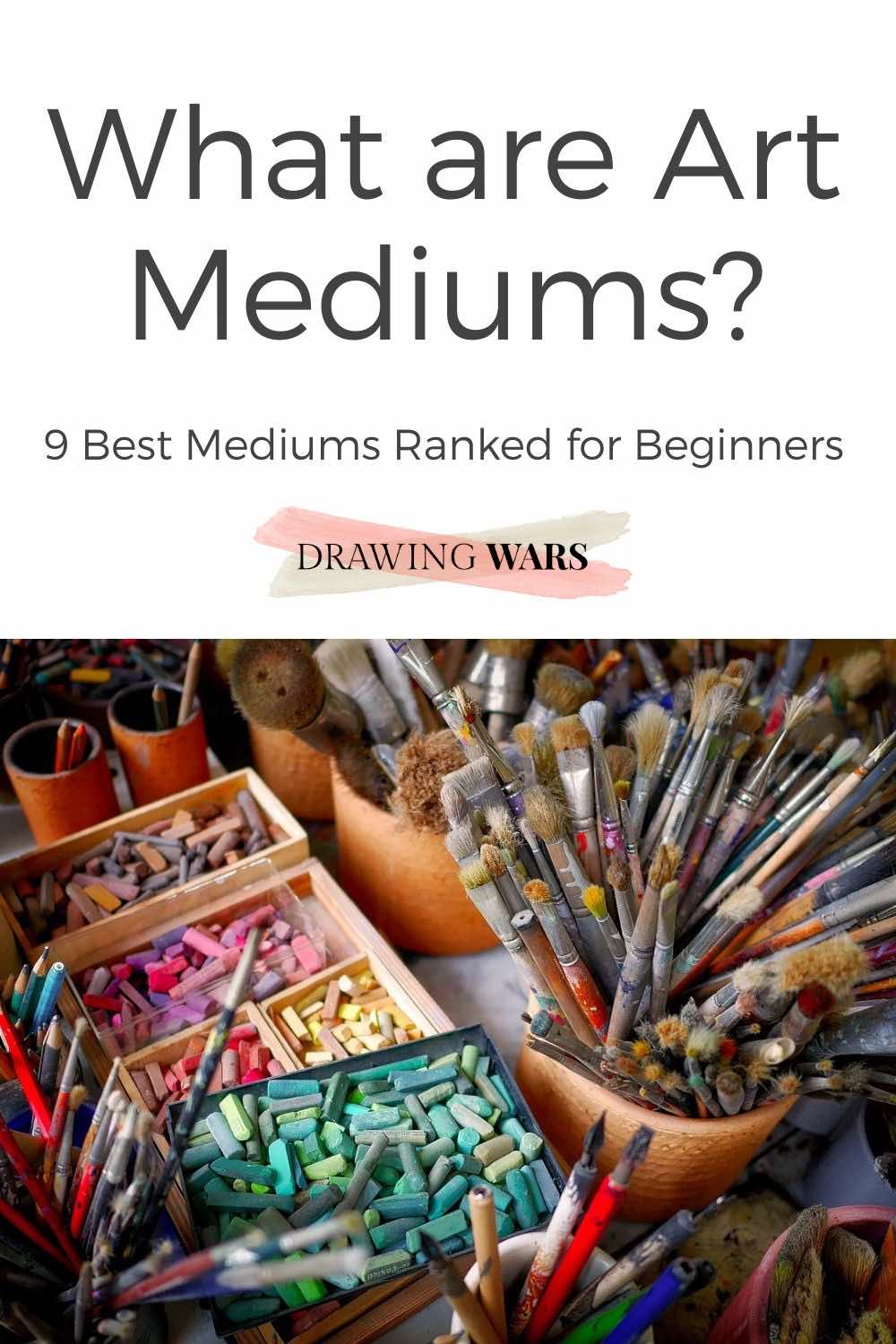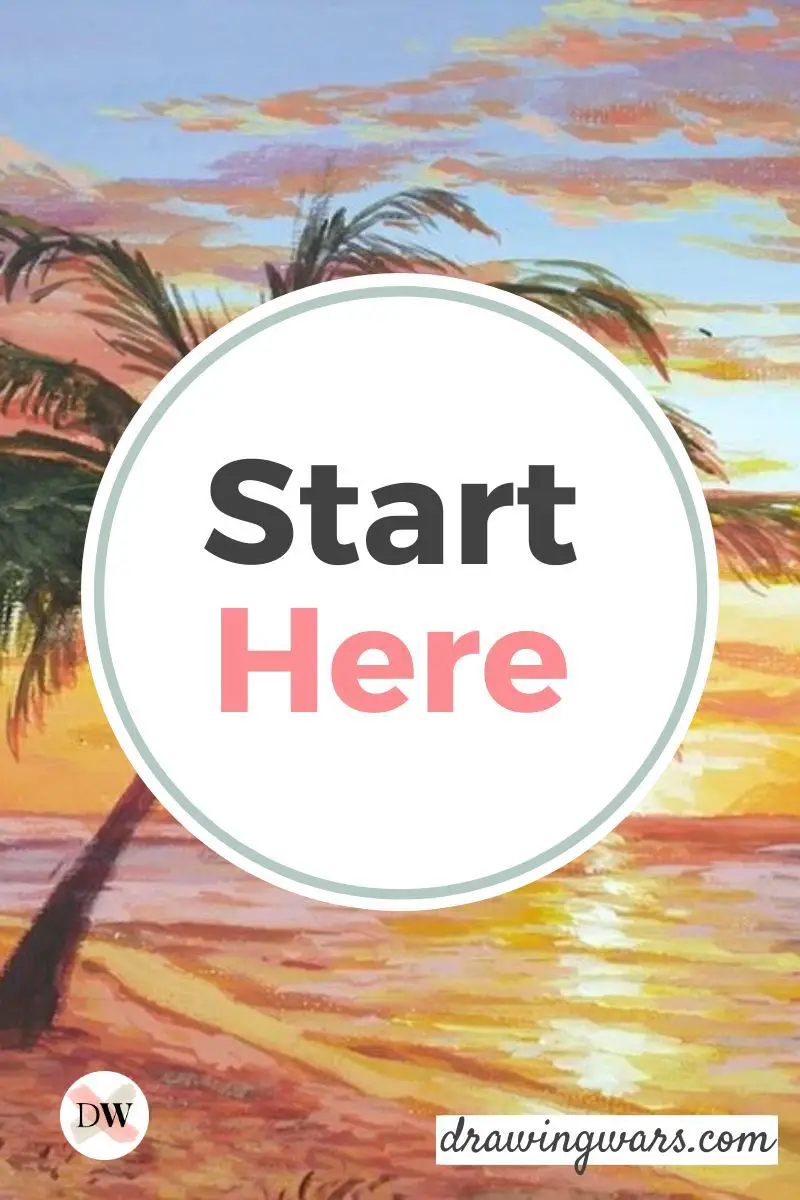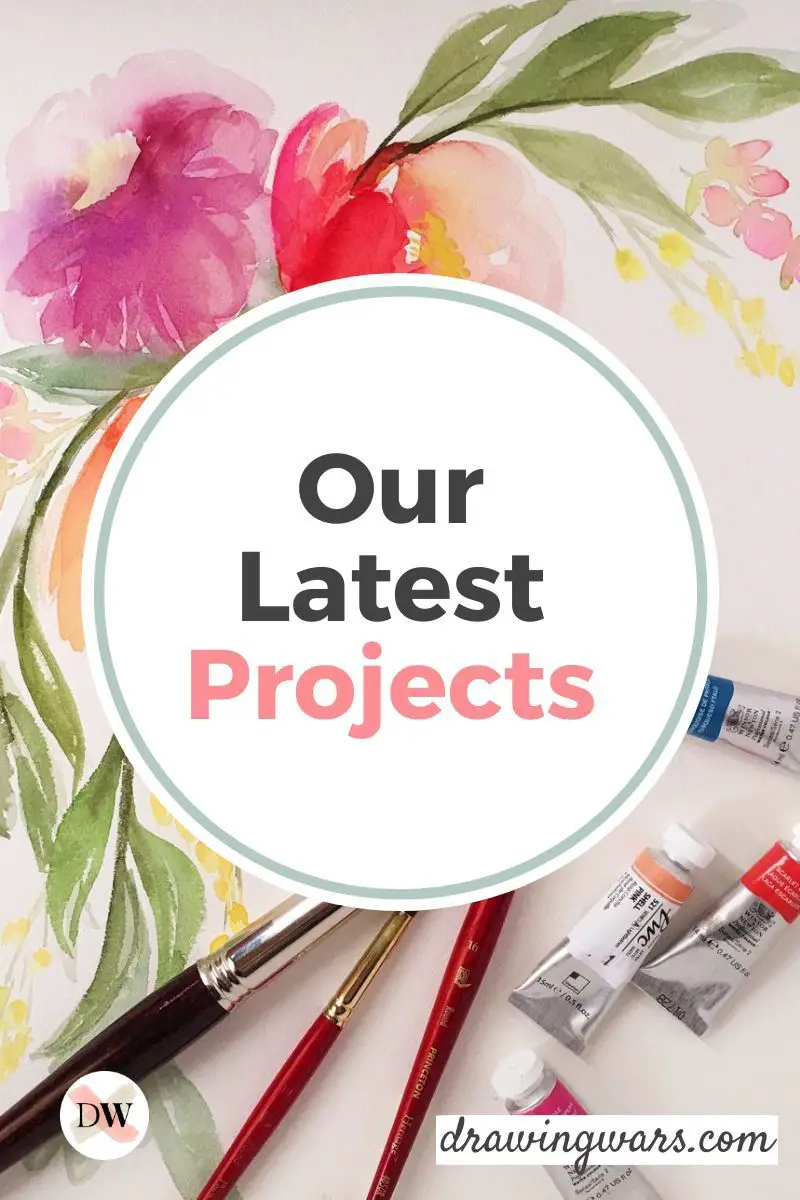

What are art mediums?
Basically, art mediums are split into dry and wet media. With dry media, the techniques are mostly related to drawing. You can paint using wet media or even created mixed media artworks using both wet and dry art mediums. So it all comes down to whether you like drawing or painting more.
Art mediums range from dry to wet media. They can be used to create drawings and paintings, depending on the inherent capabilities and how they are used. The easiest art medium for beginners is usually graphite, whereas oil is typically the most difficult to master.
9 best mediums ranked for beginners
Generally, drawing media are considered easier to control than painting ones. But it all depends on the artist and how they choose to work with their medium!
Here’s a ranking of the different mediums.
- Graphite
- Colored pencils
- Charcoal
- Soft Pastel
- Oil pastel
- Watercolor
- Gouache
- Acrylic
- Oil
1. Graphite
Graphite is the most accessible art medium of them all!
Graphite is lead-based and as an art medium, it is available in different forms. Pencil and powder are the two very common variants of graphite. It is also available in tinted shades.
We all know that graphite can be used for many purposes. Where writing is the most basic use of graphite pencils, it is the most primary medium in art too.
You’ll be surprised at the variety you can achieve with just one grade of a graphite pencil. If you only have an HB pencil, it’s more than enough to make a drawing. But to make things easier, we would recommend you get your hands on this wonderful graphite pencil set for beginners.
Other than using pencils, graphite is also available in the form of powder and compressed sticks. For beginners, we would suggest using pencils. Not only are graphite pencils available easily, but you can easily fix any mistakes that you make with them.
PRO-TIP
Use a cotton ball
Are you fond of smudging graphite to obtain shading? Instead of getting your fingers dirty, try using a cotton bud or ball.
2. Colored pencils
You can think of colored pencils as a more diverse range of graphite.
Colored pencils are generally lead based but are also available in wax. They are an easy and ideal medium for both artists and students, the grade for both of them may vary.
So what comes next after graphite? Colored pencils and there’s a good reason why. We have all grown up using them at one point or the other. Whether it is for our school projects, diagrams, drawings we made for fun - colored pencils were our go-to medium.
That being said, our hands are naturally used to them. But using colored pencils as an art medium requires different techniques.
- Firstly, you need to color in a single direction. Don’t make multiple marks and strokes, it will make the artwork look chaotic.
- For a smooth look, blend the different colored pencils together. You can also buy a colorless blender for this purpose as it could make things easier.
PRO-TIP
Water-soluble colored pencils
If you want to give a mixture of dry and wet effects, try water-soluble colored pencils. These can give the effect of watercolors, inks and other wet media while providing great control!
If you love using water in your artwork, buy water-soluble colored pencils. You can use such pencils both dry and wet. Combine dry and wet techniques into one artwork or make a series of dry and wet media artworks using just a set of these water-soluble pencils.
3. Charcoal
The feeling of pitch-black powder is great!

Charcoal is just burnt wood used to create both sketches and final drawings in art. Additionally, water can also be added to create smudgy effects.
You can think of charcoal as the classic drawing medium. Traditional artists would use it to make quick sketches and drawings all the time. And it wasn’t only because of its classic look and appeal, but also how easy it was to erase mistakes.
But what then makes it slightly difficult than graphite when it’s so easy to smudge and erase? The answer is simple - smudging can get out of control. As a beginner, it’s more likely to create a mess with charcoal than with graphite. And while charcoal is easier to smudge and erase, it is also naturally darker than graphite. So you can leave more marks and impressions on the paper while erasing. However, denting the paper is highly unlikely!
Again, like graphite, charcoal is also available in many forms. But unlike graphite, the most common choice for charcoal is a willow stick rather than a pencil. The stick makes it easy to capture dynamic movement. You can easily achieve loose and expressive strokes.
PRO-TIP
Large scale artworks
Do you love to draw big? Consider using charcoal powder instead of sticks. With the powder, you can quickly fill in large areas of the sheet. Some companies even manufacture giant charcoal chunks, so you can use them too.
But bear in mind that the larger the drawing, the more difficult it gets to manage charcoal. You’ll need to protect it by using a fixative. Fixatives are available in two types: One that gives the final touch and the other one is used for layering, known as ‘workable fixative’. As a beginner, you may benefit from a workable fixative more than one that seals off the artwork completely. Based on our experience, here’s a fixative that does the job quite well!
Krylon Fixative Aerosol Spray
Use this workable fixative on a variety of drawing media, from graphite and colored pencils to charcoal and pastels.
4. Soft Pastel
The similar texture of soft pastel and charcoal make them quite alike in handling.

Soft pastels are said to be both a drawing and a painting medium. It acts as a drawing medium if used to create lines and strokes. When used for staining the paper and blending the colors, it acts as a painting medium.
So where does soft pastel become difficult? Well, the tricky part lies in the blending and mixing of colors. Too much inappropriate and careless mixing can result in colors that look grey and dull.
And just like charcoal drawing, you would need to protect soft pastel drawings as well. Don’t consider getting all of them framed. That could cost you a lot of dollars, especially if you draw and paint with a lot!
WARNING!
use acid-free archival paper
Struggling to protect your soft pastel artworks? Stick them on foam board and cover them with acid-free archival paper. Do not use any acidic paper as it can cause the colors of the drawing to fade away and yellow with age.
5. Oil Pastel
Love the effect of oil painting? Oil pastels are your best bet!

Oil pastels have oil as a binder, making it possible to achieve oil painting effects in the form of a drawing.
The key difference between dry (soft and hard) pastels and oil pastels is simple - oil. So what makes oil pastel slightly harder than its softer counterpart is that it could get difficult to blend. Oil pastel sticks are very thick and they could even leave bits falling off here and there while you’re working with them.
PRO-TIP
Layer one color or another
Do you struggle to create tones and shades with oil pastel? Use oil pastel sticks to create thin and thick lines on top of each other. The easiest way is to do achieve oil pastel shading is to use multiple tones and shades of a single color and place the strokes next to each other.
6. Watercolor
The painting medium that's most commonly used by artists and illustrators!

Watercolor is a very common painting medium. It’s a popular choice among beginners because all you need are some brushes and a piece of paper. And you’re good to go!
However, when you consider it as a professional art medium, there are many things to take into account. First of all, you need to know the methods and techniques of watercolor. It’s not just about water and paint - it’s all about the flow and mixing multiple methods to get your desired result!
Techniques for watercolor:
Wet on dry: It is the easiest watercolor technique, hands down. Let the watercolor paper stay dry and apply wet paint over it. It’s up to you to decide exactly how wet the paint application will be.
Wet on wet: The wet-on-wet watercolor technique is mainly used to create effects. This is why it’s so good for washes and large backgrounds. Cover the entire watercolor paper with water
Dry on wet: You’ll love this technique if you’re fond of creating spontaneous washes and textures. Again, the water is more likely to spread using this technique.
PRO-TIP
Use salt to create texture
Want to create interesting watercolor paintings? Cover the watercolor paper with a large, flat-colored wash. Then add table salt crystals to watch a series of 'burst' like effects all over the sheet.
But what makes watercolor paints easy is that they require minimal materials. So they are easily accessible and affordable, and also there are minimal health hazards involved!
7. Gouache
This thick water-based paint is quite good for designs and illustrations!

So why have we put gouache after watercolor? It’s because gouache paint is quite thick. And while that can be advantageous, it could also be tricky to handle while painting.
On the other hand, the changing nature of gouache also gives artists a benefit. You can easily rework any areas by making them wet. And while that’s a positive aspect, it can be a disadvantage too. If you add too much water,
PRO-TIP
keep a cream-like consistency
Although gouache is a water-based medium, you shouldn’t use it like watercolor! Add just a bit of water to produce a cream-like consistency. Using too much water will cause the gouache paints to crack.
8. Acrylic
Acrylic is the easiest medium for painting on canvas.

Acrylic paint is the easiest if you’re looking for canvas. You would only need a jar of water and some brushes to get going on your painting. It’s also great because you could use a variety of materials to achieve different effects in a painting.
Other than brushes, here are a few materials you can use to make your acrylic painting:
- Rubber brushes
- Paper
- Cardboard
- Cotton balls
In addition to the different materials you can use to create effects, acrylic paints themselves are available in many variants according to the final sheen.
PRO-TIP
use acrylic variants
Acrylic paints are naturally glossy. But you can get them in other styles as well. For instance, matte and satin acrylic paints. Or you could even use normal acrylic paints and put a matt varnish over it instead.
Seriously, there is so much you can achieve with acrylic paints. Thin them down, tweak with their final look or just play around with 3D textures along with a knife.
But the downside of it? Acrylic dries really fast and so you have to speed up your painting process. If you can’t paint faster, we would suggest you use a retarder like this one , which slows down the acrylic paint drying time by 5 to 10 minutes.
Liquitex Professional Fluid Medium 8 oz
Mix a bit of this retarder into your acrylic paints to slow down the drying time while you're painting!
9. Oil paints
The epitome of traditional western painting - oil paints!

So why is oil difficult if it’s easy to wipe out the mistakes? Firstly, there’s not just one technique of oil painting. There are different techniques and it may be hard for someone just getting started to get a hang of it. Secondly, many beginners find it difficult to paint from the darkest shades to the lightest tones. Last, oil painting requires extra materials. Traditionally, you would need the following for an oil painting:
- Canvas
- Turpentine
- Linseed oil
The fumes from oil painting mediums such as turpentine can be very harmful to health. Not to mention, they’re also inflammable. So oil painting requires a lot of precaution.
Another part is that brushes require a lot of cleaning. You can’t simply clean oil paint brushes with water, as oil will repel it.
WARNING!
avoid suffocated places
Turpentine fumes can be harmful both in the long and short run. Always do oil painting in an open or properly-ventilated place. Additionally, you can also use an odorless thinner in place of turpentine, it will have less to no fumes!
However, there’s a good side to oil paints as well. And that is the flexibility of removing the paint at any time using turpentine or spirit. You can wipe clean your painting any time you wish. And with more and more companies coming out with safer alternatives, oil painting is becoming more accessible. However, these substitutes could be more expensive than their traditional counterparts.
If you’re interested in oil painting and don’t want to do it traditionally, you can even buy a water mixable oil paint kit like this one.
Conclusion
Hence, drawing and painting media are different to handle. Where graphite is the simplest, most affordable, and accessible drawing medium. And in painting media, watercolor takes the top spot. Oil painting is the most difficult because it requires care and precaution. Not only can the paints be difficult to handle due to a variety of techniques, but also because of additional materials and health hazards. Hence keeping all that in mind, graphite is the easiest art medium for beginners, whereas oil paints are the most difficult traditionally according to both medium and technique.
If you want to learn more about various art mediums, don’t miss this post on how watercolor compares to other painting media .
How Easy is Watercolor? Vs Acrylic, Oil & Other Mediums
Have you been struggling with watercolor? Thinking of how easy it is compared to other media? Here's all you need to know!

By Jimena & Iñigo
The Navarro-Rubios
My husband and I are learning how to draw and paint. We wanted to share this learning process with the world and have fun! That's why we created this blog. We'll have drawing contests every week and you'll decide who won that week! Follow along and learn with us!

Jimena & Iñigo
The Navarro-Rubios
My husband and I are learning how to draw and paint. We wanted to share this learning process with the world and have fun! That's why we created this blog. We'll have drawing contests every week and you'll decide who won that week! Follow along and learn with us!






